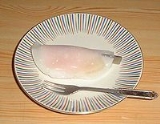
Hanabiramochi
Encyclopedia

Japan
Japan is an island nation in East Asia. Located in the Pacific Ocean, it lies to the east of the Sea of Japan, China, North Korea, South Korea and Russia, stretching from the Sea of Okhotsk in the north to the East China Sea and Taiwan in the south...
ese sweet (wagashi
Wagashi
is a traditional Japanese confectionery which is often served with tea, especially the types made of mochi, azuki bean paste, and fruits.Wagashi is typically made from natural ingredients...
), usually eaten at the beginning of the year. Hanabiramochi are also served at the first tea ceremony
Japanese tea ceremony
The Japanese tea ceremony, also called the Way of Tea, is a Japanese cultural activity involving the ceremonial preparation and presentation of matcha, powdered green tea. In Japanese, it is called . The manner in which it is performed, or the art of its performance, is called...
of the new year.
Origin
The name "hanabiramochi" literally means "flower petal mochiMochi
Mochi is a Japanese rice cake made of glutinous rice pounded into paste and molded into shape. In Japan it is traditionally made in a ceremony called mochitsuki. While also eaten year-round, mochi is a traditional food for the Japanese New Year and is commonly sold and eaten during that time...
". The original form of Hanabiramochi is Hishihanabira, a dessert that was eaten by the Imperial family
Imperial House of Japan
The , also referred to as the Imperial Family or the Yamato Dynasty, comprises those members of the extended family of the reigning Emperor of Japan who undertake official and public duties. Under the present Constitution of Japan, the emperor is the symbol of the state and unity of the people...
at special events coinciding with the beginning of the year.
Hanabiramochi was first made in the Meiji Era (8 September 1868 - 30 July 1912), but it is now a familiar New Year wagashi
Wagashi
is a traditional Japanese confectionery which is often served with tea, especially the types made of mochi, azuki bean paste, and fruits.Wagashi is typically made from natural ingredients...
.
Form
The exact shape of hanabiramochi is strictly defined by tradition. The white mochi covering is flat and round, folded over to form a semicircular shape, and must have a pink color showing through in the center of the confection, fading to a white at the edge. Unlike a daifukuDaifuku
', or ' , is a Japanese confection consisting of a small round mochi stuffed with sweet filling, most commonly anko, sweetened red bean paste made from azuki beans....
, the mochi must not completely seal the insides.
In the center of a hanabiramochi is a layer of anko
Red bean paste
Red bean paste or Azuki bean paste is a sweet, dark red bean paste originating from China. It is used in Chinese cuisine, Japanese confectionery, and Korean cuisine. It is prepared by boiling and mashing azuki beans and then sweetening the paste with sugar or honey...
, a sweet bean paste, commonly the white kind made from sweetened mung beans. In the very center is a thin strip of sweetly flavoured gobo (burdock
Greater burdock
Greater burdock, Edible burdock, or Lappa Burdock is a biennial plant of the Arctium genus in the Asteraceae family, cultivated in gardens for its root used as a vegetable.-Description:...
), which protrudes from the mochi on both sides.
Significance and Symbolism
Each element of the hanabiramochi is significant:The red colour showing through the white mochi
Mochi
Mochi is a Japanese rice cake made of glutinous rice pounded into paste and molded into shape. In Japan it is traditionally made in a ceremony called mochitsuki. While also eaten year-round, mochi is a traditional food for the Japanese New Year and is commonly sold and eaten during that time...
is not only appropriate to the celebration of the new year, but also evokes the Japanese apricot/plum (ume
Ume
Prunus mume, with the common names including Chinese plum and Japanese apricot, is an Asian tree species classified in the Armeniaca section of the genus Prunus. The flower, long a beloved subject in the traditional painting of East Asia, is usually translated as plum blossom. This distinct tree...
) blossom, which in turn represents the purity, perseverance, and renewal associated with the New Year.
The gobo
Greater burdock
Greater burdock, Edible burdock, or Lappa Burdock is a biennial plant of the Arctium genus in the Asteraceae family, cultivated in gardens for its root used as a vegetable.-Description:...
represents pressed ayu
Ayu
The or sweetfish, Plecoglossus altivelis, is an amphidromous fish, the only species in the genus Plecoglossus and in family Plecoglossidae. It is a relative of the smelts and is placed in the order Osmeriformes...
, a fish exclusive to East Asia, and a prayer for a long life.

